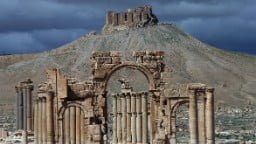The Daily Observer London Desk: Reporter- James Richards
Area: 187,437 sq km
Population: 21,563,800 (2022 est.)
Median age: 23.5 years old
Capital: Damascus
Ethnic Groups: Arab 50%, Alawite 15%, Kurd 10%, Levantine 10%, other 15% (includes Druze, Ismaili, Imami, Nusairi, Assyrian, Turkoman, Armenian)
Religion: Muslim 87% (official; includes Sunni 74% and Alawi, Ismaili, and Shia 13%), Christian 10% (includes Orthodox, Uniate, and Nestorian), Druze 3%
Unemployment: 50% (2017 est.)
1517-1918 – Part of the Ottoman Empire.
1920 – The League of Nations puts Syria under French control.
April 17, 1946 – Independence is declared after French troops leave the country.
1949-1958 – A series of coups leads to instability in the country.
February 1, 1958 – Syria and Egypt merge, creating the United Arab Republic.
September 28, 1961 – Syria secedes from the United Arab Republic.
1967 – Syria loses the Golan Heights to Israel during the Six Day War.
November 13, 1970 – Minister of Defense Hafez al-Assad stages a bloodless coup.
1976-2005 – Approximately 17,000 Syrian troops are stationed in neighboring Lebanon.
December 29, 1979-present – Syria appears on the US State Department’s list of state sponsors of terrorism.
June 10, 2000 – Hafez al-Assad dies.
July 10, 2000 – Bashar al-Assad is elected president by referendum, winning 97% of the vote. He is reelected in 2007.
March 2011-present – Civil war in Syria begins. Violence flares in Daraa after a group of teens and children are arrested for writing political graffiti. Dozens of people are killed when security forces crack down on demonstrations. The United Nations estimates that more than 300,000 people have been killed in Syria since the beginning of the civil war.
June 3, 2014 – President Assad is reelected, receiving 88.7% of the vote in the country’s first election since civil war broke out in 2011. The election is criticized by opposition groups and many Western countries.
September 22-23, 2014 – The United States and allies launch airstrikes against ISIS targets in Syria for the first time.
September 2015 – Claiming to target ISIS, Russia conducts its first airstrikes in Syria.
April 6, 2017 – The United States launches a military strike on a Syrian government airbase in response to a chemical weapons attack on civilians days prior.
October 26, 2017 – A joint report from the United Nations and international chemical weapons inspectors finds that the Assad regime was responsible for an April 2017 sarin attack that killed more than 80 people. Syria has repeatedly denied it had anything to do with the attack and also denies it has any chemical weapons.
April 13, 2018 – The US, UK and France launch strikes against targets at three sites in Syria following a week of threats of retaliation for an alleged chemical weapons attack on civilians in the Damascus enclave of Douma.
March 23, 2019 – The Syrian Democratic Forces announces that ISIS has lost its final stronghold in Syria, bringing an end to the so-called caliphate declared in 2014.
October 6, 2019 – The White House announces a major shift in US foreign policy. US forces in northern Syria will pull back in advance of a planned Turkish military offensive against Kurdish forces – who were a key ally of the United States in the fight against ISIS.
October 9, 2019 – Turkey begins its planned military offensive into northeastern Syria, launching airstrikes and artillery fire across the border. The days that follow lead to reports about the displacement of people from the area and the possibility of ISIS prisoners escaping.
October 14, 2019 – Facing a Turkish military offensive, Kurdish forces strike a deal with the Syrian government, marking a major shift in the country’s eight-year war. As part of the new alliance, units from the Syrian army reportedly arrive in northern towns to deploy troops along the entirety of the Syria-Turkey border. The next day, Russia confirms it brokered the initial talks between Turkey and the Kurdish forces. It has also begun patrolling a contact line between Syrian and Turkish forces, according to a statement from Russia’s Defense Ministry.
October 21, 2019 – At a press conference in Afghanistan, US Secretary of Defense Mark Esper says US troops in the south will remain in Syria in part to protect oil fields from ISIS. Other US troops will withdraw from northern Syria in “weeks, not days.” Four days later, he reiterates that “the United States will maintain a reduced presence in Syria to deny ISIS access to oil revenue as we reposition for the next phase of the Defeat-ISIS campaign.”
October 22, 2019 – Erdogan and Russian President Vladimir Putin unveil a 10-point shared agenda shaping the end of Syria’s civil war. Putin says Russia and Turkey agree to uphold the “sovereignty and territorial integrity” of Syria. The formerly US-backed Kurdish fighters must withdraw from the towns of Manbij and Tal Rifaat.
November 18, 2020 – Israel’s military carries out a series of strikes on targets in Syria, including a site at the Damascus International Airport used as Iranian headquarters, following the discovery of improvised explosive devices planted in the Golan Heights, according to the Israel Defense Forces.
November 14, 2021 – The US acknowledges for the first time that previously undisclosed airstrikes in Syria carried out days before the fall of ISIS in 2019 killed multiple civilians, including women and children, according to US Central Command. The disclosure followed the publication of a New York Times investigation into the strikes.



